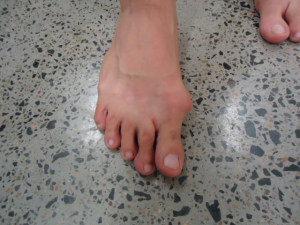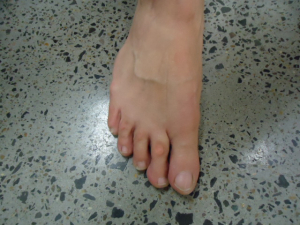Bunion surgery Sydney is one of the most common procedures performed by Dr Damien Lafferty, a podiatric surgeon with clinics in Darlinghurst and Greenwich. Using modern techniques, bunion correction is now more effective and less painful than traditional surgery, with a strong focus on realignment, recovery and long-term results.


Everything You Need To Know About Bunions
What Is a Bunion?
A bunion is a deviation of a bone in the foot. This bone begins to move away from the other bones and starts to protrude. The big toe, in turn, begins to deviate in the opposite direction — often squashing the smaller toes.
Why Do I Get a Bunion?
The most common cause of bunions is genetics. There is often a family history of bunions, and examining relatives’ feet can give insight into how your own bunions may progress.
The old belief that bunions are caused solely by tight shoes isn’t accurate. However, tight footwear and high heels can accelerate the development of a bunion.
Other contributing factors may include flat feet, repetitive stress activities, or conditions such as arthritis.
What Are the Non-Surgical Treatments for Bunions?
Once a bunion has formed, it will not go away on its own. Over time, bunions typically enlarge and the big toe continues to deviate further.
There are two main options: manage the condition conservatively, or consider surgical correction.
If you choose to manage the bunion conservatively, the following options may help reduce discomfort:
- Wearing wide or accommodating shoes
- Using custom-made orthotics
- Inserting toe spacers or cushioning pads
These measures may alleviate pain, but they will not correct the bunion itself.
Will a Brace or Splint Fix My Bunion?
No, they will not.
In some cases, splints may reduce soft tissue tightness and improve comfort, but they cannot reposition bones once a bunion has formed.
Will Manipulation or Mobilisation Fix My Bunion?
No, these treatments cannot reverse a bunion.
Manual therapies may help loosen the joint and reduce discomfort temporarily. When combined with supportive footwear and orthotics, they may relieve symptoms — but they do not fix the underlying deformity.
Bunion Surgery and Recovery
When Do I Need Surgery?
Bunion surgery is typically considered when the bunion becomes painful, interferes with wearing shoes, or begins to affect daily activities. In some cases, bunions can start to damage other structures in the foot.
While traditional bunion surgery was often painful and only temporarily effective, modern techniques have improved greatly. It is now generally recommended to correct the bunion before more serious damage occurs.
What Surgery Is Carried Out?
Modern bunion surgery techniques focus on realigning the bone properly and achieving lasting results. Older methods that damaged the joint and produced high pain levels have been replaced by minimally traumatic techniques with better outcomes.
Typically, a small incision is made. A precision bone cut is performed using a fine surgical saw, and the bone is shifted to realign the joint. The bunion bump is removed and the toe is straightened.
Is Minimally Invasive or Keyhole Surgery Appropriate?
In selected cases, minimally invasive (MIS) or keyhole surgery may be suitable. However, in well-established or severe bunions, a small open incision is typically required. These incisions are now much smaller and result in minimal scarring.
What Is Recovery Like After Bunion Surgery?
Surgery is usually performed as a day procedure, meaning no hospital stay is needed. Patients can typically walk immediately using a special post-operative shoe. While limited activity is expected in the first week, walking short distances (e.g. to the bathroom or kitchen) is allowed.
After 7 days, dressings are changed at your first post-operative review. By 2 weeks, the bulky dressing is replaced with a small dressing following daily saltwater soaks. Most patients return to normal footwear by 3 to 4 weeks, although healing timelines vary.
When Can I Drive After Bunion Surgery?
You should avoid driving while wearing a post-operative shoe and large dressing. Typically, this means a driving break of 2 to 3 weeks for safety reasons.
Is Bunion Surgery Painful?
Modern bunion surgery is significantly less painful than older techniques. Smaller incisions and less tissue trauma mean less discomfort. Many patients report little to no post-operative pain, especially when guided by current medication protocols.
Will My Bunion Come Back After Surgery?
Modern procedures are designed to be permanent. The goal is to correct the deformity once — and not need repeat surgery. However, as with all medical procedures, there is a small chance of recurrence.
What Complications Can Occur?
Bunion surgery is safe and complications are uncommon, but all surgery carries some risks. General surgical risks include infection, unexpected pain, anaesthetic reactions, and deep vein thrombosis (DVT).
Specific risks may include:
- Bone slippage after correction
- Movement of surgical screws or pins
- Excess scar formation
- Wound contractures
Side effects from medications like nausea or vomiting may also occur.
All potential risks are discussed in detail during your pre-operative consultation, where you’re encouraged to ask any questions.
